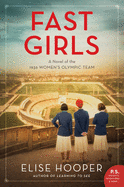
Imagine the determination of Olympic competitors. Then, add sexism, racism and poverty to their challenge. Fast Girls follows the experiences of real-life track and field U.S. Olympians Betty Robinson, Helen Stephens, Louise Stokes and their teammates. As in Learning to See, her novel about photographer Dorothea Lange, Elise Hooper combines meticulous research with fictionalized details.
Culminating in the infamous 1936 Olympics in Hitler's Berlin, Hooper's story begins in 1928, when 16-year-old Betty wins a gold medal in the Amsterdam games, after being denied the right to train with her Illinois high school boys' track team. Meanwhile, Helen, 10, longs to stretch her lanky frame and run on her family's Missouri farm. And Louise's Massachusetts track coach declares her "the speediest girl" he's ever seen, but sports will interfere with the after-school jobs that help support her family.
Like the relay team they'll later form, Fast Girls moves among the young athletes and their teammates and rivals, as each struggles with her circumstances. Betty is crippled at 19 in a plane crash; the Depression costs Helen's family their farm. Funding is unreliable. When Louise earns a spot at the Los Angeles trials, she and the other Black runner are housed in the attic of the contingent's Denver hotel en route. Irregular judging and politics abruptly exclude competitors, adding to the tension leading to Berlin: Who will run? While the ending isn't a question, anxiety heightens when the athletes reach Nazi Germany, and the Führer himself shows an interest in the American women runners. Their success is a satisfying climax, and in a fascinating afterword Hooper summarizes the lives of nine of the Fast Girls after 1936. --Cheryl McKeon, bookseller, Market Block Books, Troy, New York

